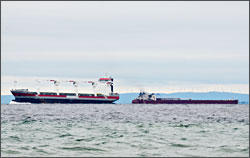Graveyard of the Great Lakes
For 200 years, a bottleneck on the east end of Lake Superior has claimed ships and lives.

© Beth Gauper
In 1816, the first schooner built for Lake Superior shipping also became first to sink. It was called the Invincible, but it was no match for winds whipping off the east end of Michigan's Upper Peninsula.
The Invincible wreck was the first of hundreds along what become known as the Shipwreck Coast. The last — we hope — was the Edmund Fitzgerald, which went down in 1975 with 29 lives lost.
At Whitefish Point, not far from the Soo Locks, the lake narrows into a funnel where shipping lanes converge, visibility is poor and northwesters reach full fury, building up over 200 miles of open water.
Lake Superior's first lighthouse was built here in 1848, urged on by New York editor Horace Greeley: "Every month's delay is virtual manslaughter," he wrote.
Today, the complex includes the second tower, built in 1861 with keeper's quarters, a 1923 Coast Guard Lifeboat Station crew's quarters and a 1936 fog-signal building.
In 1985, a decade after the wreck of the Fitzgerald, a museum opened.
Today, the Great Lakes Shipwreck Museum is a popular stop on the Circle Tour of Lake Superior. The first thing tourists see when they enter is the Fitz's bell, recovered from 535 feet of water in 1995.
As visitors circumnavigate the museum, they see exhibits that include salvaged artifacts and read like tombstones: The Independence, 1844-1853, lost when its boiler exploded. The Niagara, 1872-1897, overloaded with iron ore and sunk in a storm. The Comet, 1857-1875, rammed by the Manitoba and sunk with 10 lives lost.
As dangerous as storms could be, collisions sunk more boats. The wooden steamer Osborn, 1882-1884, was the fourth boat in a month done in by the steel-hulled passenger liner Alberta, which liked to go faster than it should even in thick fog.

© Beth Gauper
In 1909, the Isaac M. Scott struck the John B. Cowles, with 14 lives lost and licenses of both pilots suspended. The worst loss of life by collision came in 1920, when the Willis King and Superior City confused passing signals and hit each other, with the loss of 29 lives.
Technology and better training eventually improved safety. But not much could be done about the storms.
The last obituary is for the Edmund Fitzgerald, sunk in a vicious November gale, and no one really knows what caused its demise.
Among the theories: The 729-foot boat hit a little-known reef while trying to avoid the storm and damaged its hull.
Its steel and welds were overstressed from its years as a Great Lakes workhorse.
Faulty hatch covers allowed water from 35-foot waves to enter the hold.
It was hit by the Three Sisters, a Lake Superior phenomenon in which two rogue waves strike, followed by a third massive wave that overwhelms the boat as it struggles to recover.
Many experts believe it was all of the above. After an investigation, the Coast Guard, National Transportation Safety Board and Lake Carriers Association came to three different conclusions.
The museum campus includes a theater, where visitors watch a short movie about shipwrecks whose opening and closing music was — what else? — "The Wreck of the Edmund Fitzgerald."
They can visit the keeper's quarters, suspended in 1929 with realistic models of keeper Robert Carlson and his family. They can scale the lighthouse tower for a sweeping view of passing boats and the sandy point, covered with driftwood and detritus from storms.

© Torsten Muller
The white-frame Coast Guard crew's quarters once was an inn, run by the Great Lakes Shipwreck Historical Society.
In summer, tourists stream past its front yard, sometimes stopping to admire the giant rudder and tiller salvaged from the Drake, which sank in 1901 off Whitefish Point.
"History is not in the past here," a couple from Ontario had written in the guest book. "It is the present that is alive with the people and stories of the past."
Trip Tips: Whitefish Point near Paradise, Mich.
Getting there: It's a little more than an hour west of Sault Ste. Marie, and about 5¼ hours east of Green Bay.

© Torsten Muller
Great Lakes Shipwreck Museum: It's open daily from May through October. Admission is $13, $9 for children 5-17. Entrance to the lighthouse tower is an extra $4.
Events: August, Wild Blueberry Festival in Paradise.
Every Nov. 10, the museum holds a service to commemorate the loss of the ship and its crew of 29, ringing the ship's salvaged bronze bell 29 times.
There are many outdoors events at nearby Tahquamenon Falls State Park. For more, see Tales of Tahquamenon.
Where to stay: The neighboring town of Paradise has several motels, including the Paradise Inn, Curley's Motel and the Magnuson Grand, on the lake.

© Beth Gauper
Twenty miles to the southwest, Tahquamenon Falls State Park has a camper cabin and a three-bedroom lodge that sleeps eight. There's also modern and rustic camping.
Dining: In Paradise, the Inn Gastropub & Smokehouse serves sandwiches and burgers.
Whitefish Point Bird Observatory: In spring, thousands of migrating birds are funneled past the point, and naturalists begin to band long-eared and saw-whet owls. In fall, raptors, ducks and shorebirds migrate past the point.
Nearby attractions: Tahquamenon Falls State Park is a popular place to hike and play in the water of the Lower Falls.
For a fun day, hike the 4½-mile River Trail from the Lower Falls to the Upper Falls. Have lunch at the Tahquamenon Falls Brewery & Pub or Big Falls Snacks, then hike back.
For $7 per person, you can rent a rowboat and row over to the Lower Falls, actually two sets of rapids and waterfalls around an island.